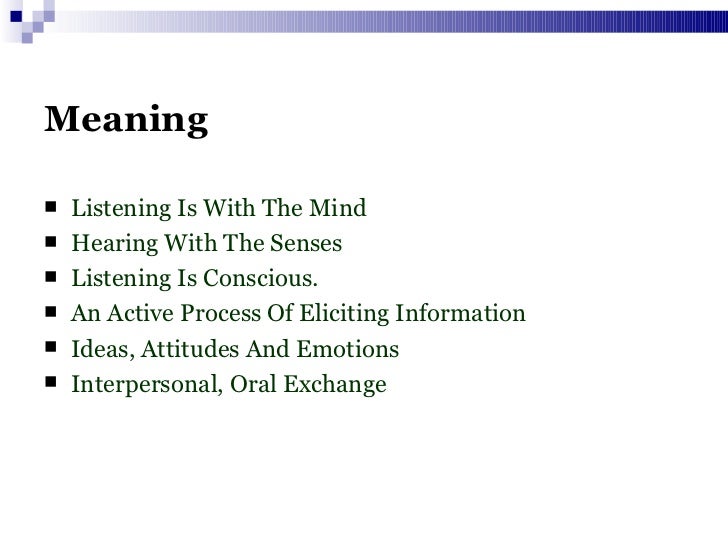

We use our ears to receive individual sounds as we listen (letters, stress, rhythm. For example, one uses appreciative listening when listening to good. Passive listening is little more than hearing. What is Listening Listening is through the ears, receiving language.


Someone may also practice appreciative listening if it contributes to achieving a goal or meeting a need. Reflective listening is a special type of listening that involves paying respectful attention to the content and feeling expressed in another persons’ communication. Even if it’s necessary, it never gets easier. Appreciative listening is a way of listening in which someone actively goes in search of certain auditory information that this person personally appreciates or likes. Listening is following the thoughts and feelings of another and understanding what the other is saying from his or her perspective. Disclosing similar situations: “I was also conflicted about returning to work after the birth of my son.” “I had the responsibility of terminating some of my personnel, due to downsizing, over the last two years.Waiting to disclose your opinion: “Tell me more about your proposal to reorganize the department.” “Can you please provide some history for me regarding your relationship with your former business partner?”.Asking specific questions: “How long do you expect your hiring process to last?” “What is your average rate of staff turnover?”.Which aspect of his critique was most disturbing?” “It’s clear that the current situation is intolerable for you. For communication to be effective, it must be clear, correct, complete, concise, and compassionate. : to be alert to catch an expected sound. It can occur in person, on the internet (on forums, social media, and websites), over the phone (through apps, calls, and video), or by mail. : to hear something with thoughtful attention : give consideration. Asking open-ended questions: “I can see that John's criticism was very upsetting to you. Communication occurs in many forms, including verbal and non-verbal, written, visual, and listening.I appreciate your time in speaking to me.” Brief verbal affirmation: “I understand that you'd like more frequent feedback about your performance.” “Thank you.Paraphrasing: “So, you're saying that the uncertainty about who will be your new supervisor is creating stress for you.” “So, you think that we need to build up our social media marketing efforts.”.Demonstrating concern: “I'm eager to help I know you're going through some tough challenges.” “I know how hard a corporate restructuring can be.Building trust and establishing rapport: “Tell me what I can do to help.” “I was really impressed to read on your website how you donate 5% of each sale to charity.”.


 0 kommentar(er)
0 kommentar(er)
